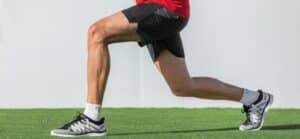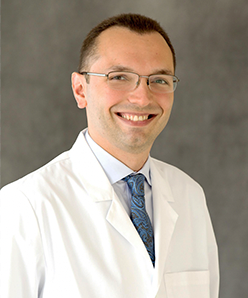Femur Fracture in Westchester County, NY

A femur fracture, or a break in the thighbone, is a significant and painful injury. As one of the strongest bones in the body, the femur typically fractures due to high-impact events, such as trauma from a motor vehicle accident.
Treatment generally involves stabilizing and immobilizing the leg. In more severe cases, surgical intervention may be necessary to promote proper healing and alignment.
Dr. Valdet Nikci and Dr. Yasmin Dahr at Specialty Orthopaedics in Harrison, New York, specialize in diagnosing and treating complex lower body injuries, including femur fractures.
Types of Femur Fractures
Femur fractures can differ based on how and where the bone breaks. The thighbone is divided into three main parts, and the location of the fracture may fall into one of these categories:
- Proximal Femur Fractures: These occur at the upper part of the bone, near the hip joint.
- Femoral Shaft Fractures: These happen in the middle section of the bone and are often severe.
- Supracondylar Femur Fractures: These are less common and occur just above the knee.
Femur fractures can also be classified by the way the bone breaks:
- Transverse Fracture: A clean, straight break across the bone.
- Oblique Fracture: A break at an angle.
- Spiral Fracture: A twisting break that wraps around the bone.
- Comminuted Fracture: The bone shatters into multiple pieces.
- Displaced Fracture: The broken bone ends are out of alignment.
- Open (Compound) Fracture: The broken bone pierces through the skin, often causing damage to muscles and tendons around it.
These distinctions help doctors determine the best treatment plan for each type of fracture.
Symptoms of a Femur Fracture
Symptoms of a femur fracture include:
- Severe pain
- Swelling
- Tenderness
- Physical deformity
- Often, the inability to walk
Diagnosis of a Femur Fracture
Our doctors diagnose a femur fracture by examining the leg and using imaging tests like X-rays or CT scans. These tests help pinpoint the exact location and severity of the break.
Treatment of a Femur Fracture
The treatment for a femur fracture depends on the location and severity of the break. It often includes:
- Stabilizing the leg
- Using a splint or cast to keep the leg immobile
- Prescribing medication to manage pain
If the broken pieces of bone are out of alignment, they may need to be repositioned before the leg is splinted or casted. This can involve either nonsurgical or surgical methods, depending on how far the bones are displaced.
For more severe fractures, intramedullary rodding is a common surgical approach. A metal rod is inserted into the center of the femur to keep the bone stable and aligned as it heals. In some cases, an external fixation device, which uses a rod and pins outside the body, may be used. Plates and screws might also be required to hold the bone in place.
Physical therapy is a crucial part of recovery, helping rebuild strength, improve movement, and restore flexibility. Most people recover from a femur fracture in about four to six months.
Why Choose Specialty Orthopedics?
At Specialty Orthopaedics, Dr. Yasmin Dhar and Dr. Valdet Nikci deliver expert care for a variety of orthopedic conditions. Dr. Dhar, a board-certified sports medicine specialist, is highly skilled in treating sports-related injuries such as ACL tears, rotator cuff injuries, and cartilage damage, using advanced surgical techniques to restore function and mobility.
Dr. Nikci is also a board-certified orthopaedic surgeon who has years of experience managing fractures and other complex injuries. He graduated from the University of Pennsylvania School of Medicine and completed advanced training at Columbia University Medical Center. Both doctors provide evidence-based care to support each patient’s recovery and long-term health.
Frequently Asked Questions
What Are the Most Common Causes of Femur Fractures Besides Car Accidents?
While car accidents are a leading cause of femur fractures, other common causes include falls from significant heights, sports injuries, and direct blows to the thigh during activities like skiing or contact sports. In older adults or those with osteoporosis, even a low-impact fall can lead to a femur fracture.
How Can I Tell the Difference Between a Femur Fracture and a Severe Muscle Strain?
A femur fracture typically involves severe pain that makes standing or walking impossible, along with visible swelling, bruising, or deformity in the thigh. A muscle strain, while painful, usually allows some degree of movement and does not cause the leg to appear misshapen. Imaging tests such as X-rays are often required to confirm the diagnosis.
What Should I Do Immediately After a Suspected Femur Fracture?
If you suspect a femur fracture, you should immobilize the leg right away to prevent further injury. Do not move the person unless absolutely necessary, and call for emergency medical assistance. Applying ice to the injured area may help reduce swelling while waiting for professional care.
How Long Does It Take to Recover From Femur Fracture Surgery?
Recovery from femur fracture surgery typically takes four to six months, although this can vary depending on the extent of the injury and the treatment used. Physical therapy is often a big part of the recovery process, helping to restore strength, flexibility, and mobility.
Will a Femur Fracture Increase My Risk for Arthritis Later in Life?
A femur fracture can increase the risk of developing arthritis, particularly if the fracture extends into a joint or if proper alignment is not maintained during healing. Prompt treatment and follow-up care, including physical therapy, can help minimize the long-term impact on joint health.
Schedule Your Appointment Today
If you have symptoms of a femur fracture, Specialty Orthopaedics in New York has a team of fellowship-trained orthopedists with expertise in various orthopedic conditions. They provide thorough care for musculoskeletal injuries in a supportive and attentive environment.
For more information or to schedule a consultation, call the office at 914.686.0111 or fill out the form on this page today.








